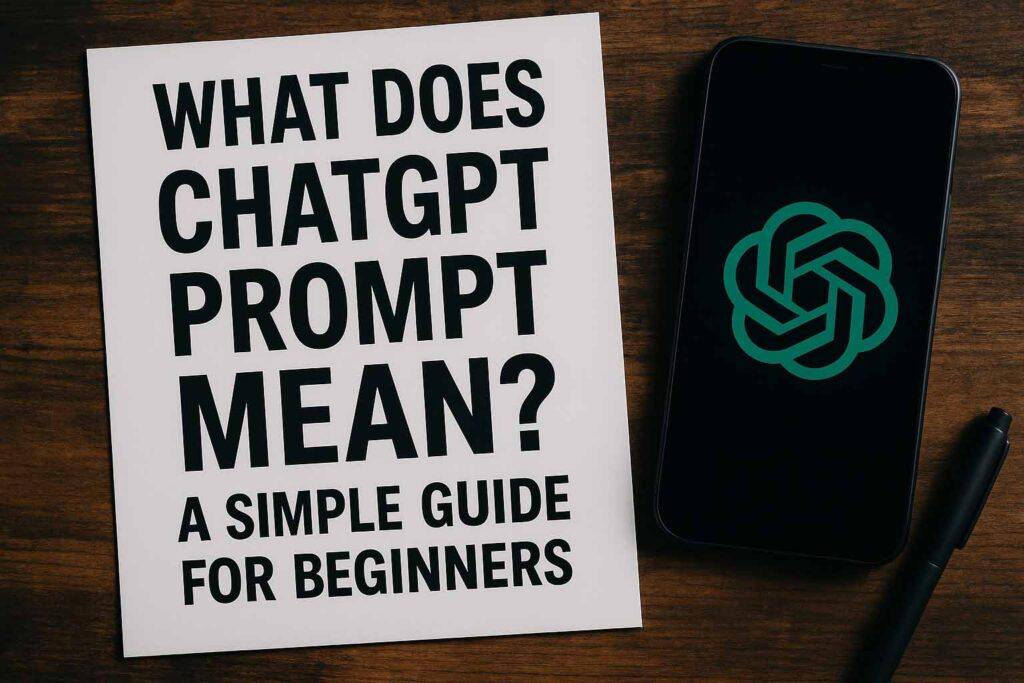7 Powerful Secrets: How to Structure a ChatGPT Prompt for Jaw-Dropping Results
Table of Contents
ChatGPT has taken the world by storm, offering incredible capabilities in text generation, problem-solving, and creative assistance. Yet, many users find themselves underwhelmed by generic or off-target responses. The culprit? Often, it’s not the AI, but the way we communicate with it. The key to unlocking truly jaw-dropping results lies in understanding how to structure a ChatGPT prompt with precision and intent.
If you’ve ever wondered why your ChatGPT outputs are merely “okay” while others are producing intricate, insightful, and highly tailored content, this guide is for you. We’re about to delve into seven powerful secrets of ChatGPT prompt engineering that will transform your interactions with this revolutionary AI. Mastering these techniques for how to structure a ChatGPT prompt will elevate your ChatGPT output quality from mundane to magnificent, enabling you to leverage its full potential.
First, What Exactly is a ChatGPT Prompt?
Before we dive into the secrets of how to structure a ChatGPT prompt, it’s essential to understand what a prompt is. In simple terms, a prompt is the instruction or query you provide to ChatGPT. It’s the starting point for your conversation and dictates the direction and quality of the AI’s response. For a more foundational understanding, you might find it useful to explore what does ChatGPT prompt mean? in greater detail. The effectiveness of this initial input is paramount.
Why is Meticulous Structuring of a ChatGPT Prompt So Crucial?
You might think that a simple question should yield a simple, good answer. While ChatGPT is designed to understand natural language, the more clarity, context, and direction you provide, the better it can meet your specific needs. Vague prompts lead to vague answers. Conversely, a well-structured prompt acts like a finely tuned set of instructions for a brilliant assistant. Understanding how to structure a ChatGPT prompt correctly is the difference between getting a rough sketch and a detailed masterpiece. It minimizes ambiguity, guides the AI’s “thought process,” and ensures the output aligns closely with your desired outcome. This attention to detail in crafting ChatGPT prompts is what separates novice users from power users achieving consistently superior results. The ability to articulate your needs effectively through careful instruction is central to understanding how to structure a ChatGPT prompt.
The 7 Powerful Secrets to Structuring ChatGPT Prompts
Let’s unlock the advanced techniques that will revolutionize how to structure a ChatGPT prompt for exceptional outcomes.
Secret 1: The Power of Explicit Roles and Personas
One of the most transformative ChatGPT prompt tips is to assign a specific role or persona to ChatGPT before you ask your main question. This primes the AI to respond from a particular viewpoint, with a specific style, and with access to relevant knowledge associated with that role.
- Explanation: Instead of just asking a question, tell ChatGPT who it should be. For example, “Act as an experienced marketing strategist,” or “You are a witty Shakespearean poet.”
- Why it Works: Assigning a role helps ChatGPT narrow its focus, adopt an appropriate tone, and utilize domain-specific vocabulary and conventions. This simple step in how to structure a ChatGPT prompt can dramatically improve the relevance and sophistication of the response.
- Example:
- Weak Prompt: “Write about the benefits of content marketing.”
- Strong Prompt (with Role): “Act as a seasoned digital marketing consultant with 20 years of experience. Explain the key benefits of content marketing for a small e-commerce business, using clear, persuasive language.”
- This approach demonstrates an effective way for how to structure a ChatGPT prompt.
Secret 2: Defining the Audience for Precision
Just as important as defining ChatGPT’s role is specifying the intended audience for its response. The way you explain a concept to a child is vastly different from how you’d explain it to a PhD expert. This is a critical element in how to structure a ChatGPT prompt.
- Explanation: Clearly state who the generated content is for. Is it for beginners, experts, potential customers, technical staff, or a general audience?
- Why it Works: Knowing the audience allows ChatGPT to tailor the complexity of the language, the depth of explanation, the examples used, and the overall tone. Effective ChatGPT prompts always consider the end-user. The nuance of how to structure a ChatGPT prompt includes this audience-centric approach.
- Example:
- Weak Prompt: “Explain quantum computing.”
- Strong Prompt (with Audience): “Explain the basic concept of quantum computing to a high school student with no prior physics knowledge. Use simple analogies and avoid jargon.”
- Mastering how to structure a ChatGPT prompt involves thinking about who will read the output.
Secret 3: The Art of Contextual Background & Constraints
ChatGPT doesn’t inherently know the backstory or specific limitations of your request unless you provide them. Supplying relevant context and clear constraints is fundamental to knowing how to structure a ChatGPT prompt for focused results.
- Explanation: Include any necessary background information, previous parts of a conversation (if starting fresh), specific data points, or limitations (e.g., “Do not mention competitors,” “Focus only on organic solutions”).
- Why it Works: Context helps ChatGPT understand the nuances of your request, preventing it from making incorrect assumptions or generating overly broad answers. Constraints keep the AI on track. This is a vital part of crafting ChatGPT prompts that yield precise answers. Understanding how to structure a ChatGPT prompt means providing a rich informational landscape.
- Example:
- Weak Prompt: “Suggest a marketing slogan.”
- Strong Prompt (with Context & Constraints): “Our company, ‘EcoBloom,’ sells organic gardening supplies. We are targeting environmentally conscious millennials. Suggest 5 short, catchy marketing slogans (under 7 words each) that highlight sustainability and ease of use. Avoid using the word ‘green’.”
- This detailed instruction exemplifies a superior method for how to structure a ChatGPT prompt.
Secret 4: Specifying Format, Tone, and Length
Do you need a bulleted list, a formal essay, a casual blog post, or a tweet? How long should it be? What should the emotional tone be? These are crucial details when considering how to structure a ChatGPT prompt.
- Explanation: Explicitly tell ChatGPT the desired output format (e.g., “Provide the answer in a table with three columns,” “Write a poem in AABB rhyme scheme”), the tone (e.g., “enthusiastic,” “skeptical,” “professional,” “humorous”), and the approximate length (e.g., “in about 200 words,” “a short paragraph,” “three key bullet points”).
- Why it Works: This eliminates guesswork for the AI and ensures the output is delivered in a practical and usable manner, fitting your specific requirements. This aspect of how to structure a ChatGPT prompt directly impacts ChatGPT output quality.
- Example:
- Weak Prompt: “Tell me about renewable energy.”
- Strong Prompt (with Format, Tone, Length): “Write an optimistic and informative blog post intro (approximately 150 words) about the future of renewable energy. End with a question to engage readers.”
- Detailed formatting requests are part of knowing how to structure a ChatGPT prompt well.
Secret 5: Incorporating Examples (Few-Shot Prompting)
One of the most advanced ChatGPT prompts techniques is “few-shot prompting,” where you provide one or more examples of the kind of input-output pairing you desire. This “show, don’t just tell” approach is highly effective in how to structure a ChatGPT prompt.
- Explanation: Include a few examples of what you’re looking for directly in your prompt. This helps the AI understand the pattern, style, or specific transformation you need.
- Why it Works: Examples provide concrete illustrations, often conveying nuances that are hard to describe in words alone. ChatGPT can then extrapolate from these examples to generate similar outputs for your new input. This is a cornerstone of effective ChatGPT prompt engineering and a sophisticated way for how to structure a ChatGPT prompt.
- Example:
- Prompt (with Few-Shot):
“Translate the following English sentences into a formal, slightly archaic French, like a 19th-century diplomat might speak.
English: Hello, how are you today?
French: Salutations, Monsieur/Madame, comment vous portez-vous en ce jour?
English: I need to discuss an important matter.
French: Il m’est impérieux de m’entretenir avec vous d’une affaire de haute importance.
English: The weather is quite pleasant.
French:” - This illustrates a powerful method for how to structure a ChatGPT prompt.
- Prompt (with Few-Shot):
Secret 6: Iterative Refinement and Chain-of-Thought Prompting
Don’t expect the first prompt to be perfect, especially for complex tasks. Effective use involves an iterative process. Furthermore, encouraging a “chain-of-thought” can lead to better reasoning for complex problems. Knowing how to structure a ChatGPT prompt includes planning for refinement.
- Explanation:
- Iterative Refinement: Start with a decent prompt, review the output, identify areas for improvement, and then refine your prompt accordingly. Treat it as a conversation.
- Chain-of-Thought (CoT): For complex reasoning tasks, ask ChatGPT to “think step-by-step” or “explain its reasoning” before giving the final answer.
- Why it Works: Iteration allows you to hone in on the perfect phrasing. CoT prompting encourages the AI to break down a problem into smaller, manageable steps, often leading to more accurate and logical conclusions. This is a key ChatGPT prompt tip for improving ChatGPT output quality. The process of learning how to structure a ChatGPT prompt is itself iterative.
- Example (CoT):
- “Solve this word problem and show your reasoning step-by-step: If John has 5 apples and gives 2 to Jane, then Jane gives John 1 back, how many apples does John have?”
- Refining prompts is integral to mastering how to structure a ChatGPT prompt.
Secret 7: Leveraging Negative Constraints (What NOT to Do)
Sometimes, telling ChatGPT what not to include or do can be just as powerful as telling it what to do. This is a subtle but effective technique in how to structure a ChatGPT prompt.
- Explanation: Include explicit negative constraints in your prompt. For example, “Do not use jargon,” “Avoid mentioning price,” “Exclude any information after 2021,” “Do not write in a passive voice.”
- Why it Works: Negative constraints help to further narrow the scope of the AI’s response, preventing it from veering into unwanted territories or including undesirable elements. This fine-tuning is part of advanced ChatGPT prompt engineering. Understanding how to structure a ChatGPT prompt also means knowing what to forbid.
- Example:
- Weak Prompt: “Write a product description for a new smartphone.”
- Strong Prompt (with Negative Constraints): “Write a compelling product description for the new ‘Nova X’ smartphone. Focus on its camera capabilities and battery life. Do not compare it to other brands, and avoid technical specifications like RAM or processor speed. Keep the tone excited but professional.”
- Using exclusions helps refine how to structure a ChatGPT prompt.
Putting It All Together: An Example of a Well-Structured Prompt
Let’s combine several of these secrets to demonstrate an advanced approach to how to structure a ChatGPT prompt:
“Act as an expert travel blogger specializing in budget-friendly solo travel for young adults (20-25 years old).
Context: I’m planning a 7-day trip to Southeast Asia in July. My budget is $700 excluding flights. I’m interested in cultural experiences and nature, not partying.
Task: Create a suggested itinerary for a 7-day solo trip to ONE country in Southeast Asia that fits this budget and interest.
Format: Provide the output as a day-by-day itinerary in a bulleted list. For each day, suggest 1-2 activities and an estimated cost.
Tone: Enthusiastic, adventurous, and practical.
Length: The entire itinerary should be concise, approximately 300-400 words.
Audience: For a young adult looking for actionable travel advice.
Examples (Style for activity description):
- Explore the ancient temples of Angkor Wat (Day pass: $37)
- Hike to the Kuang Si Falls and swim in the turquoise pools (Entry: $2.50)
Negative Constraints: Do not suggest luxury accommodations or expensive tours. Avoid mentioning countries that have complex visa requirements for US citizens.”
This detailed prompt showcases a sophisticated understanding of how to structure a ChatGPT prompt for high-quality, tailored results. The knowledge of how to structure a ChatGPT prompt this way is what leads to consistently better outputs.
Common Pitfalls in Crafting ChatGPT Prompts (Beyond the Secrets)
Even when aware of how to structure a ChatGPT prompt, some common pitfalls include:
- Overly Complex Prompts: While detail is good, a single prompt trying to achieve too many disparate things can confuse the AI. Break down very complex tasks.
- Ambiguous Language: Use clear, precise wording. Avoid slang or idioms that the AI might misinterpret.
- Assuming Prior Knowledge: Don’t assume ChatGPT remembers specifics from previous, separate chat sessions unless you are in a continuous conversation or provide that context. Every new interaction often requires a full understanding of how to structure a ChatGPT prompt for that specific instance.
Conclusion: Your Journey to Prompt Mastery
The ability to effectively communicate with AI is rapidly becoming a crucial skill. By understanding and implementing these seven powerful secrets on how to structure a ChatGPT prompt, you move from being a passive user to an active director of ChatGPT’s capabilities. Remember that ChatGPT prompt engineering is both an art and a science; it requires practice, iteration, and a willingness to experiment.
Start applying these ChatGPT prompt tips today. Define roles, specify your audience, provide context, dictate format, use examples, iterate, and employ negative constraints. As you master how to structure a ChatGPT prompt, you’ll unlock a new level of productivity and creativity, consistently generating jaw-dropping results that truly meet your needs. The journey of learning how to structure a ChatGPT prompt is ongoing, but these secrets provide a powerful foundation.
For further reading on language model prompting, consider exploring authoritative resources like OpenAI’s own documentation on best practices for prompt engineering (or a similar high-quality LLM prompting guide if the link changes).
Frequently Asked Questions (FAQ)
- Q1: How important is grammar and spelling when I structure a ChatGPT prompt?
- A: While ChatGPT is quite robust at understanding minor typos, clear and grammatically correct prompts generally yield better results. Significant errors can lead to misinterpretations. Precision in how to structure a ChatGPT prompt extends to clear language.
- Q2: Can I combine multiple “secrets” into one prompt?
- A: Absolutely! In fact, the most effective ChatGPT prompts often combine several of these techniques (role, audience, format, context, examples) to provide comprehensive instructions. The example in the “Putting It All Together” section demonstrates this. Knowing how to structure a ChatGPT prompt often means layering these strategies.
- Q3: How long can a ChatGPT prompt be?
- A: ChatGPT models have a token limit (which includes both your prompt and its generated response). While you can write quite lengthy prompts, it’s often more effective to be concise yet comprehensive. If a task is extremely complex, consider breaking it into smaller, sequential prompts. A key part of understanding how to structure a ChatGPT prompt is managing its length relative to the desired output.
- Q4: What if I’m still not getting the desired results after trying these secrets on how to structure a ChatGPT prompt?
- A: ChatGPT prompt engineering is iterative. If your initial refined prompt isn’t perfect:
- Simplify your prompt to see if a more basic version works, then gradually add complexity.
- Re-evaluate if the task is suitable for the current capabilities of ChatGPT.
- Try rephrasing: sometimes a slight change in wording when you structure a ChatGPT prompt can make a big difference.
- Break the task into smaller sub-tasks.
- A: ChatGPT prompt engineering is iterative. If your initial refined prompt isn’t perfect:




